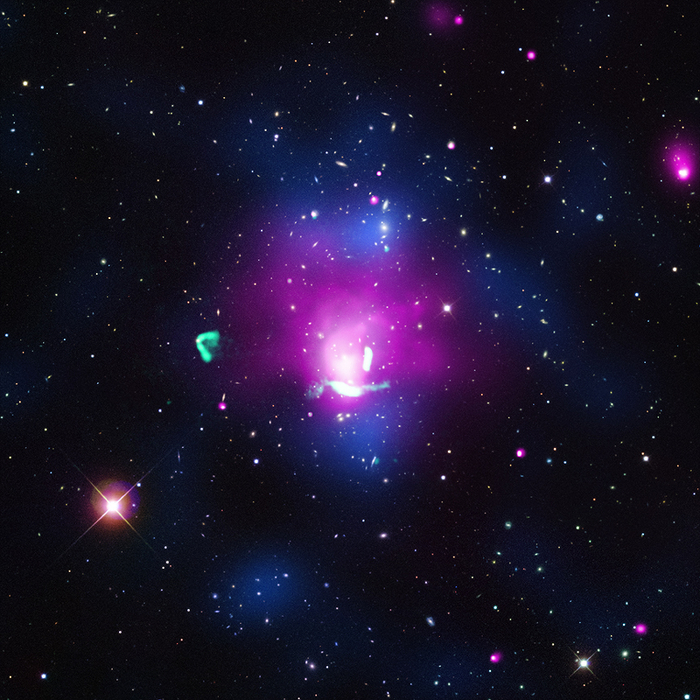
 Credit: X-ray: NASA/CXC/Univ of Hamburg/F. de Gasperin et al; Optical: SDSS; Radio: NRAO/VLA
Credit: X-ray: NASA/CXC/Univ of Hamburg/F. de Gasperin et al; Optical: SDSS; Radio: NRAO/VLA
Radio Phoenix Reawakened
When actively feeding, supermassive black holes at the centers of galaxies produce enormous amounts of energy. They also can emit enormous, narrow lobes of radio radiation produced by jets of charged particles ejected from the space near the black hole. After some time, as the black hole's food supply dwindles, the black hole's activity wanes, and eventually, the radio lobes fade away. Now astronomers think they've found evidence of an old radio lobe whose radio emission has been rejuvenated by the collision of one cluster of galaxies with another. These clusters, called Abell 1033, is shown above in a multi-wavelength image combining radio emission from the Jansky Very Large Array (in green), X-ray emission from the Chandra X-ray observatory (in pink), and an optical image from the Sloan Digital Sky Survey. The rejuvenated radio lobe, called a "radio phoenix" by astronomers, is visible as a narrow band of green just below the center of the X-ray emission near the center of the image. Astronomers believe that the collision of the two sub-clusters in Abell 1033 produced giant shock waves, like cosmic sonic booms, which collided with and re-energized the fossil radio lobe. The X-ray emission seen by Chandra shows hot gas in the clusters which may have been disturbed by the same collision that caused the re-ignition of radio emission. Understanding the processes which occur in these colliding clusters help astronomers understand how galaxy clusters, the largest gravitationally bound objects known, grow and evolve. Because these rejuvenated radio structures quickly fade, astronomers think they may be seeing this "radio phoenix" soon after it arose from its ashes.
Published: September 14, 2015
<
HEA Dictionary ● Archive
● Search HEAPOW
● Other Languages
● HEAPOW on Facebook
● Download all Images
● Education ● HEAD
>

Each week the HEASARC
brings you new, exciting and beautiful images from X-ray and Gamma ray
astronomy. Check back each week and be sure to check out the HEAPOW archive!
Page Author: Dr. Michael F. Corcoran
Last modified Tuesday, 27-Feb-2024 10:06:35 EST


